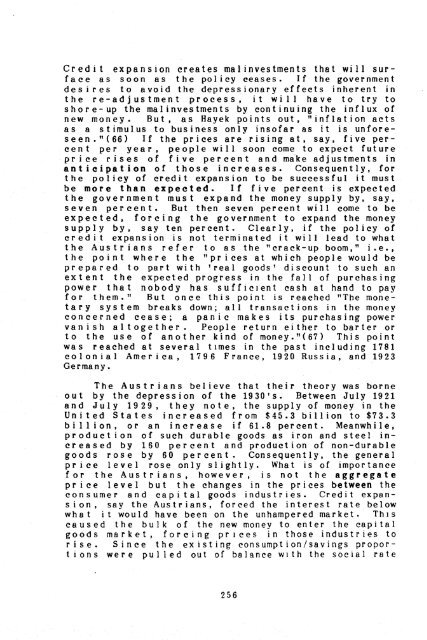Freedom, Society, and State - Ludwig von Mises Institute
Freedom, Society, and State - Ludwig von Mises Institute
Freedom, Society, and State - Ludwig von Mises Institute
Create successful ePaper yourself
Turn your PDF publications into a flip-book with our unique Google optimized e-Paper software.
ere d t t e x pan s ton ereate s rna linvestrn e n t s t hat wi lIsur <br />
face as soon as the policy ceases. If the government<br />
des i res to avoid the depressionary effects inherent in<br />
the re-adjustment process, it will have to try to<br />
shore-up the malinvestments by continuing the influx of<br />
new money. But, as Hayek points out, "inflation acts<br />
as a stimulus to business only insofar as it is unforeseen."(66)<br />
If the prices are rising at, say, five percen<br />
t per year, people will soon come to expect future<br />
price rises of five percent <strong>and</strong> ma"ke adjustments in<br />
ant i c i pat ion 0 f tho s e inc rea s e s • Conseq ue n t 1y, for<br />
the policy of credit expansion to be successful it must<br />
be more than expected. Iff i ve percent is expected<br />
the government must exp<strong>and</strong> the money supply by, say,<br />
seven percent. But then seven percent will come to be<br />
expected, forcing the government to exp<strong>and</strong> the money<br />
supply by, say ten percent .. Clearly, if the policy of<br />
credit expansion is not terminated it will lead to what<br />
the Austrians refer to as the "crack-up boom," i.e.,<br />
the point where the "prices at which people would be<br />
prepared to part with 'real goods' discount to such an<br />
extent the expected progress in the fall of purchasing<br />
power that nobody has sufficIent cash at h<strong>and</strong> to pay<br />
for them." But once this point is reached "The monetary<br />
system breaks down; all transactions in the money<br />
co nee r ned c e a s e; a pan i c ma k esits purchas i ng power<br />
van i sh al together. People return ei ther to barter or<br />
to the use of another kind of money."(67) This point<br />
was reached at several tImes in the past including 1781<br />
colonial America, 1796 France, 1920 Russia, <strong>and</strong> 1923<br />
Germany.<br />
The Austrians believe that their theory was borne<br />
out by the depression of the 1930's. Between July 1921<br />
<strong>and</strong> July 1929, they note, the supply of money in the<br />
United <strong>State</strong>s increased from $45.3 billion to $73.3<br />
b ill ion, 0 ran inc rea s e if 61.8 per cen t . Meanwh i Ie,<br />
product i on of such durable goods as iron <strong>and</strong> steel increased<br />
by 160 percent <strong>and</strong> production of non-durable<br />
goo d s r 0 s e b y 6 0 per c e n t. Conseq ue n t I y, the genera 1<br />
pr ice level rose only slightly. What is of importance<br />
for the Austrians, however, is not the aggregate<br />
pr ice level but the changes in the prices between the<br />
consumer <strong>and</strong> capital goods industries. Credit expans<br />
ion, say the Austr ians, forced the interest rate below<br />
what it would have been on the unhampered market. ThIS<br />
caused the bulk of the new money to enter the capital<br />
goods market, forcing prIces in those industries to<br />
rise. Since the existing consumption/savings proportions<br />
were pulled out of balance wIth the social rate<br />
256
















